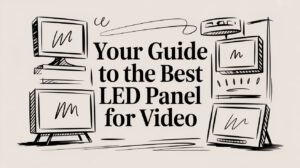
Your Guide to the Best LED Panel for Video
So, what exactly is a professional led panel for video? Think of it less like a traditional TV and more like a high-tech, luminous building
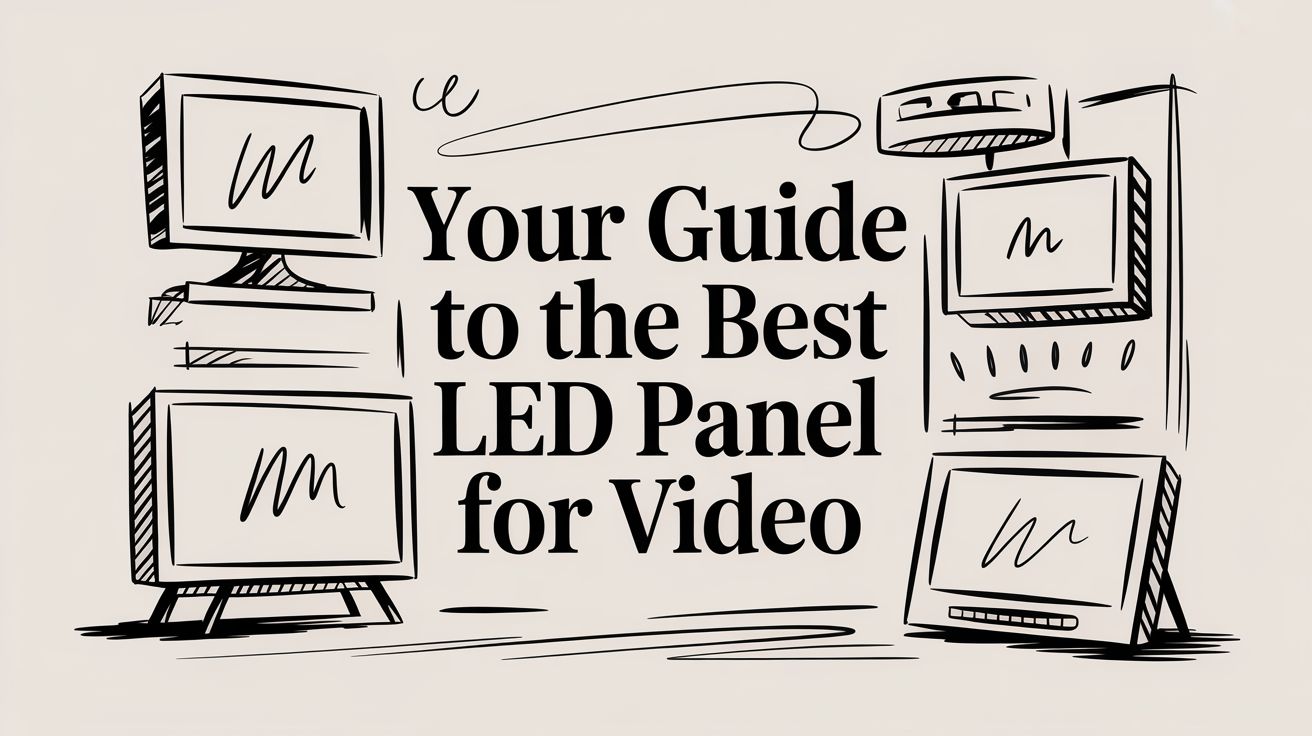
So, what exactly is a professional led panel for video? Think of it less like a traditional TV and more like a high-tech, luminous building block. These individual panels are designed to connect seamlessly, letting you create a digital canvas of virtually any size or shape you can imagine.
This is what makes them perfect for everything from massive concert stages and towering digital billboards to stunningly immersive home theaters.
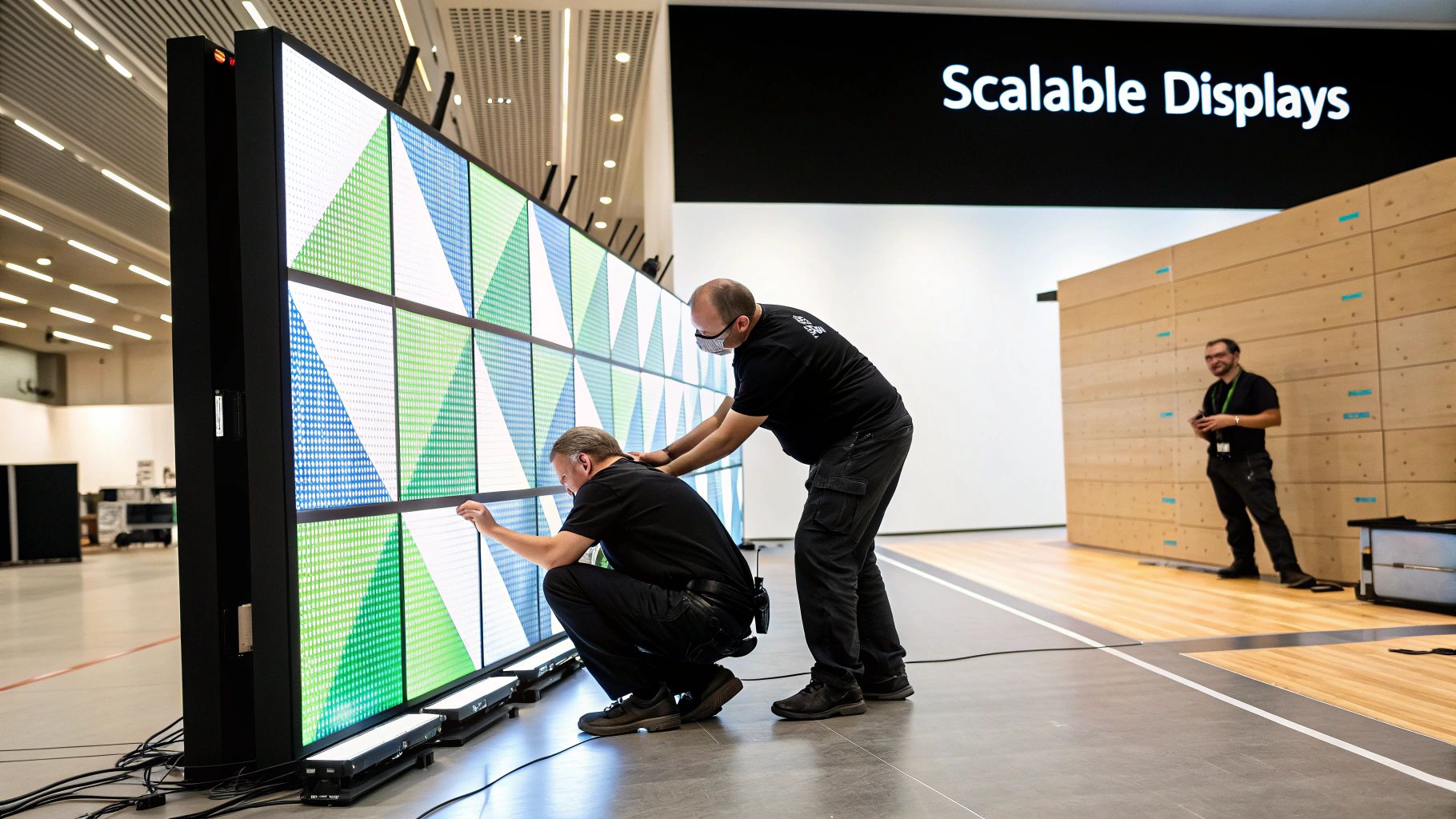
At its heart, an LED video panel is a modular tile packed with hundreds, sometimes thousands, of individual light-emitting diodes (LEDs). The best way to picture it is like a set of high-tech digital Lego bricks. You can click them together to build a video wall that fits your space perfectly, whether that’s a jaw-dropping backdrop for a conference room or a massive screen wrapping around a building.
This modularity is the technology’s real superpower. It completely shatters the rigid limitations of traditional screens. Suddenly, you're free to get creative with size, scale, and even shape—curved walls, architectural integrations, and gigantic canvases are all on the table.
The true magic of a professional LED video panel is its power to deliver absolutely stunning visual experiences in almost any environment. It gives businesses, creators, and event producers a tool to grab attention in ways that just weren't possible before. The market is exploding for a reason.
The global LED video wall market is expected to jump from around USD 14.98 billion in 2025 to a massive USD 33.87 billion by 2033. This incredible growth is being driven by constant innovation and the fact that everyone—from retail to corporate to live events—is adopting this technology. You can dig deeper into these market trends and their drivers to see just how fast things are moving.
This boom is all thanks to a few key advantages that put LED panels head and shoulders above other displays like projectors or LCD screens.
By combining these strengths, a high-quality led panel for video becomes more than just a screen. It’s a powerful tool for communication and entertainment that transforms passive viewing into an active, immersive experience.
Getting this foundation right is the first step. Next, we’ll dive into the nitty-gritty technical details that really define performance, from pixel pitch to refresh rates. An experienced partner like Smart LED Inc. is key to navigating these choices and engineering a system that perfectly nails your goals and fits your budget.
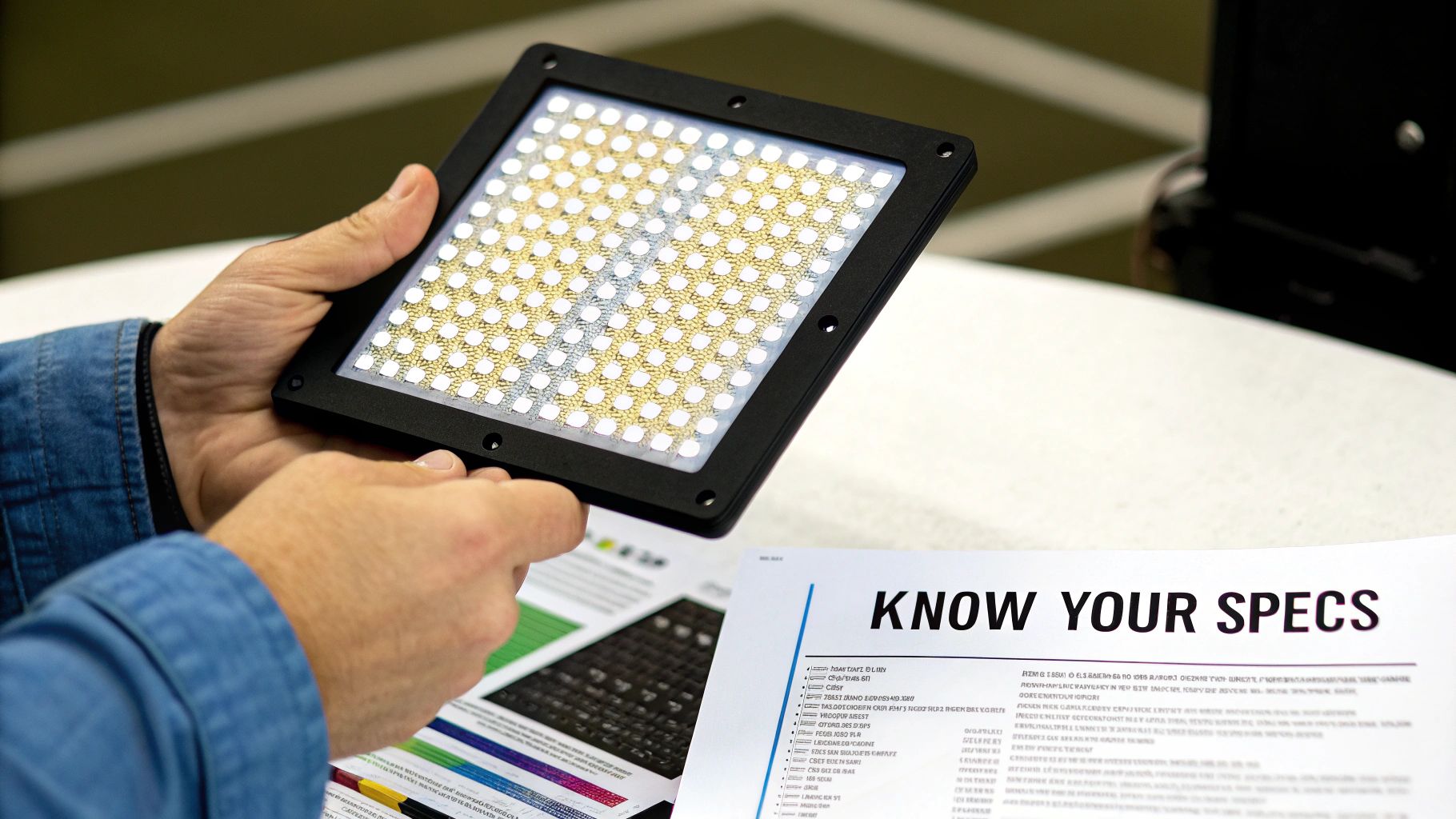
Choosing the right led panel for video can feel like you're learning a new language. You get hit with a wall of technical terms like pixel pitch, nits, and hertz. But once you get a handle on the core concepts, you can confidently pick a display that nails your vision without blowing your budget.
These specs aren't just numbers on a sheet; they are the DNA of your video wall's performance. Getting them right is the difference between a stunning, seamless image and a pixelated, flickering mess that completely undermines your project. Let's break down the most important ones into plain English.
If there’s one spec to burn into your memory, it’s pixel pitch. This is simply the distance, measured in millimeters, from the center of one tiny LED pixel to the center of the next one. The smaller the number, the closer the LEDs are packed together.
Think of it like a newspaper photo. From a distance, it looks like a clean image. Get up close, though, and you’ll see it’s just a bunch of tiny dots. A smaller pixel pitch is like using smaller, denser dots—it creates a much sharper, more detailed picture, especially when you're standing right in front of it.
This is why a digital billboard on the highway can get away with a 10mm pitch or higher—no one’s looking at it from five feet away. But for a corporate boardroom or a high-end home theater, you’ll need a much finer pitch, like 2.5mm or even 1.8mm, to keep the image perfectly crisp for those nearby.
A finer pixel pitch directly translates to a higher pixel density and, therefore, a higher resolution within a given physical area. This is the foundation of a sharp, professional-looking display.
Understanding this relationship is everything. A panel like the FX2 2.5mm LED video wall from Smart LED Inc. is a great example of how that tight pixel spacing delivers incredible clarity for indoor stages and broadcast studios where every detail matters.
When choosing a pixel pitch, the viewing distance is your guide. The closer your audience, the smaller the pitch needs to be.
This table helps you determine the ideal pixel pitch for your LED panel based on how far away your audience will be. A smaller pitch is better for closer viewing.
| Pixel Pitch (mm) | Minimum Viewing Distance | Optimal Viewing Distance |
|---|---|---|
| 1.2mm | ~4 feet (1.2 meters) | ~8 feet (2.4 meters) |
| 1.8mm | ~6 feet (1.8 meters) | ~12 feet (3.6 meters) |
| 2.5mm | ~8 feet (2.5 meters) | ~16 feet (5 meters) |
| 3.9mm | ~13 feet (4 meters) | ~26 feet (8 meters) |
| 5.9mm | ~20 feet (6 meters) | ~40 feet (12 meters) |
| 10mm | ~33 feet (10 meters) | ~66 feet (20 meters) |
Use these numbers as a starting point. It's always best to test a panel in person if you can, but this gives you a solid framework for making an informed choice.
While pixel pitch is about the detail up close, resolution is about the total number of pixels across your entire video wall. It’s the horizontal pixels multiplied by the vertical pixels.
A common mistake is looking at the resolution of a single panel and thinking that's the whole story. Your final video wall is a mosaic of many panels, and its total resolution is what determines if your content looks sharp or blocky on a massive scale.
So, to build a true Full HD display, you need to assemble enough panels to hit at least 1920 pixels across and 1080 pixels down. The finer your pixel pitch, the smaller the physical wall you'll need to hit that resolution target.
The brightness of an LED panel is measured in nits. Think of a nit as a unit of light intensity. The higher the nit rating, the brighter the screen can blast. This is absolutely critical for figuring out where your display can actually be used.
An indoor screen that's too bright will give your audience a headache. An outdoor screen that’s too dim will look like a washed-out ghost during the day.
Two final specs make all the difference for smooth, professional video: refresh rate and color calibration.
Refresh Rate, measured in Hertz (Hz), tells you how many times per second the display redraws the entire image. A low refresh rate is what causes that awful flicker you sometimes see on camera. For any project involving streaming or recording, a broadcast-grade refresh rate of 3840Hz or higher is non-negotiable.
Color Calibration is the process that ensures every single panel in your video wall looks identical. Without it, you get a distracting "checkerboard" effect where some panels are a slightly different shade or brightness. Proper calibration, both at the factory and on-site, guarantees your wall looks like one massive, seamless canvas with perfectly consistent color.
Technical specs tell you what a led panel for video can do, but seeing them in action shows what they can achieve. When you move off the spec sheet and into the real world, these displays are completely transforming all kinds of spaces, across countless industries. Each application solves a unique problem, turning what could be a simple screen into a powerful tool for engagement, communication, and even art.
From roaring stadiums to intimate corporate halls, LED tech adapts to the specific needs of the space and the audience. The real magic is in their modular nature, which gives creators a level of freedom that was once impossible. It's all about building seamless visual experiences that genuinely captivate and inform.
Let's dive into some of the most impactful ways they're being used.
The outdoors is the ultimate stress test for any display. You're fighting direct sunlight, unpredictable weather, and the need for people to see the screen from far, far away. This is where outdoor LED panels, built for high-impact performance, really shine.
Think about any modern sports stadium. Those massive, brilliant screens are absolutely essential for showing instant replays, fan-cams, and sponsor ads. The displays have to be tough enough to handle whatever the weather throws at them and bright enough—often hitting over 5,000 nits—to make sure every single person in the venue has a perfect view, even on a bright, sunny day.
That same rugged technology is what powers the world of Digital Out-of-Home (DOOH) advertising. Towering billboards in city squares or along busy highways use large-format LED panels to run dynamic, can't-miss ads that can be changed in an instant. This gives advertisers a level of flexibility and immediacy that old-school static billboards just can't touch.
When you move indoors, the game changes. The focus shifts from raw power to refined detail. This is where fine-pitch LED panels come into play, perfect for environments where the audience is up close and image quality is everything. The goal here is to build immersive, seamless backdrops that elevate the experience without drawing attention to the tech behind it.
Corporate events and big presentations are a perfect example. A vibrant, high-resolution LED wall behind a keynote speaker creates a polished, dynamic stage that looks incredible both in person and on camera. When you start thinking about all the uses for LED panels, it's crucial to see how they fit into the bigger production picture. For example, exploring strategies for mastering corporate event video production shows just how visuals and content need to work hand-in-hand.
Other popular indoor applications include:
The versatility of indoor LED video panels allows them to serve as both a functional tool and an architectural design element, transforming lobbies, auditoriums, and stages into dynamic spaces.
One of the most exciting new frontiers for LED technology is the high-end home theater. For years, projectors owned this space, but they always came with a major compromise—you needed a completely dark room. An LED video wall completely shatters that limitation.
Because it creates its own light with incredible brightness and contrast, an LED screen delivers a punchy, vibrant cinematic experience even with the lights on. This technology brings the color accuracy and dynamic range of a commercial cinema right into your home, creating a seamless "digital wallpaper" that offers an unparalleled viewing experience for movies, sports, and gaming.
This rapid adoption across both commercial and residential spaces is fueling some incredible market growth. The LED video wall display market is projected to jump from USD 6.85 billion in 2025 to USD 15 billion by 2032. This surge highlights the rising demand for advanced visual solutions everywhere, from smart cities to private homes.
Getting your carefully crafted content from a computer onto a massive, vibrant led panel for video display might seem like magic. It's not. It’s actually a surprisingly logical and reliable journey from point A to point B, ensuring every single pixel of your video arrives exactly where it needs to go.
Let's break it down using a simple analogy: a mail delivery system. Your video source is the post office, the processor is the central sorting facility, and the individual LED panels are the mailboxes, each waiting for its specific piece of the message.
Everything begins at the media source. This is simply the device holding your content—it could be a dedicated media server, a laptop running presentation software, or even a live camera feed.
This source spits out a standard video signal, usually through an HDMI or DisplayPort cable, just like you’d connect to a regular computer monitor. At this stage, the signal contains the entire video frame, like one giant, unsorted bag of mail for an entire city. It's the raw material for the rest of the system.
The signal’s next stop is the most important piece of the puzzle: the video processor. Think of this box as the master sorting facility for our mail delivery system. It’s a powerful piece of hardware that takes that single incoming video signal and gets it ready for the unique size and shape of your specific LED wall.
A processor has a few critical jobs:
This processing step is what makes a seamless, large-format display possible. To get the best results, it also helps in understanding video compression, which affects how efficiently a signal reaches the screen.
Once the processor has mapped everything out, it sends the data down standard Ethernet cables to the LED panels. This is where sending cards (inside the processor) and receiving cards (inside each LED cabinet) take over. The sending card is like a fleet of delivery trucks leaving the sorting facility, each with a specific route.
Each truck—the Ethernet cable—carries the data for a particular group of panels. When the signal arrives, the built-in receiving card on the panel acts like the local mail carrier. It grabs the data meant only for its panel and tells the individual LEDs exactly what color and brightness to be at any given moment.
The real magic happens in the synergy between the video processor and this network of sending and receiving cards. It’s what ensures every single pixel on your massive video wall gets the right information at the right time, thousands of times per second.
This entire ecosystem, from source to processor to panel, is what creates that stunning final image. A robust system, anchored by a powerful unit like a studio-grade LED video processor, is the key to managing high-resolution content without a single hiccup.
The infographic below shows this journey from the content source to the final display across all kinds of different applications.
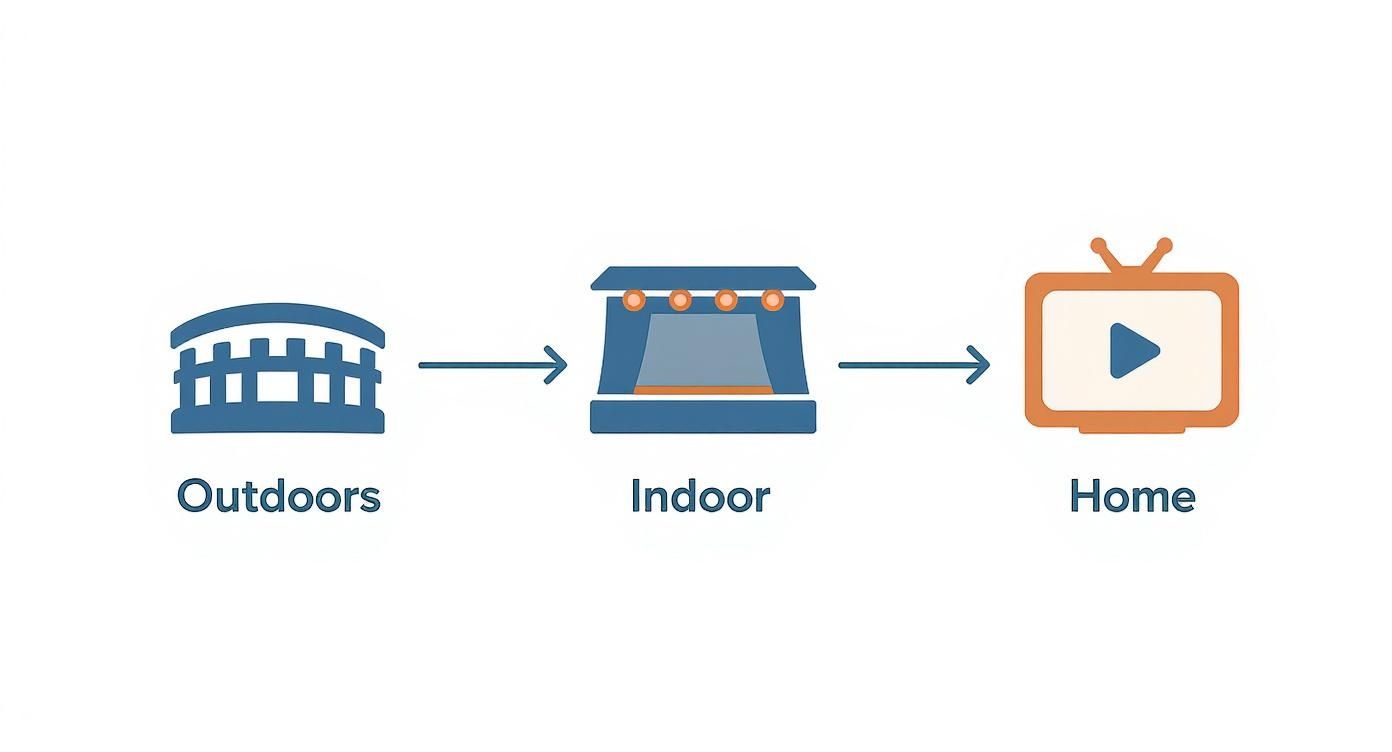
This visual flow highlights the core components that drive every LED application, whether it’s a giant stadium screen or an immersive home theater.
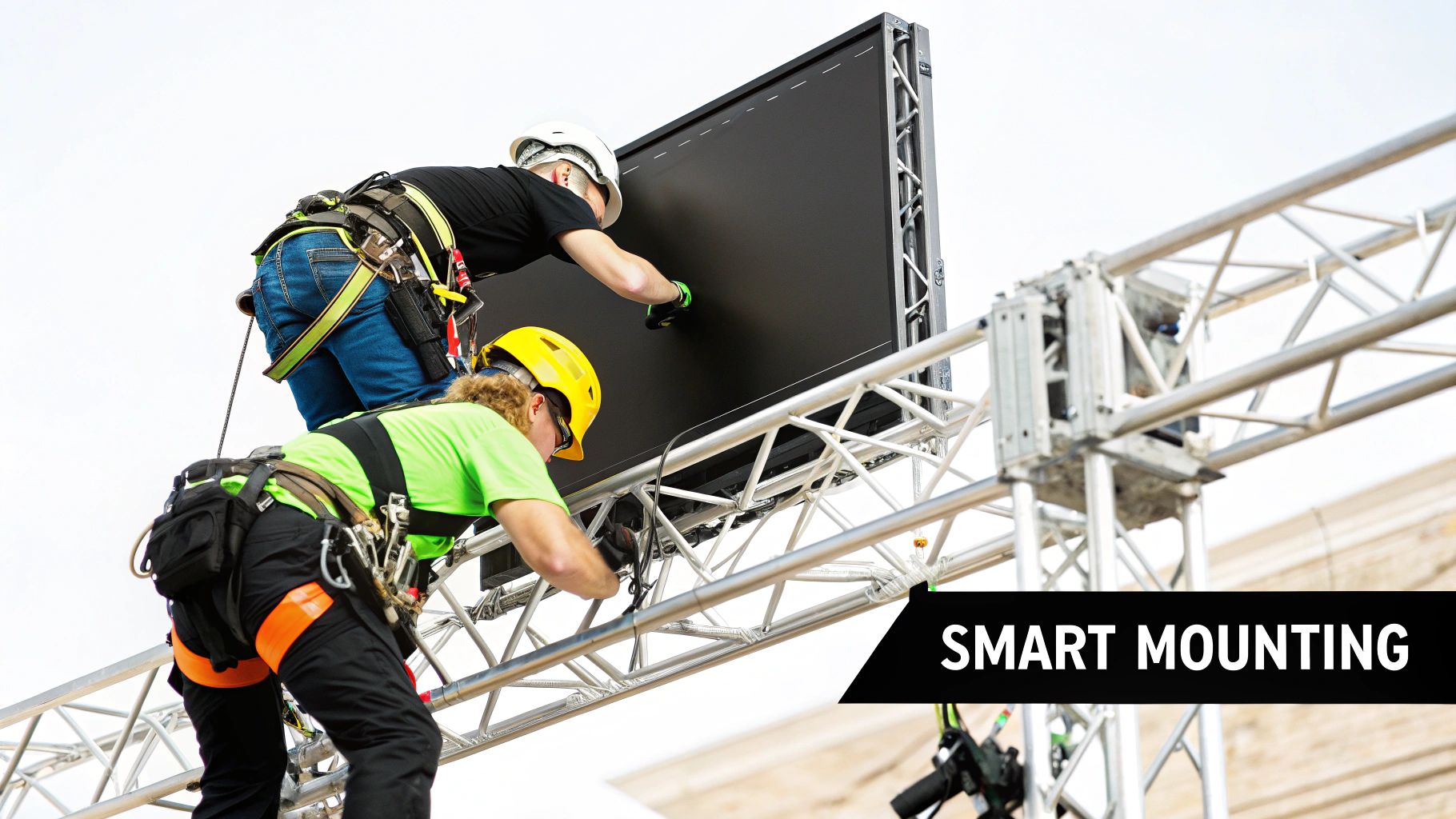
A brilliant display is only as good as its installation. The physical setup of a professional led panel for video is where your digital vision becomes a structural reality. Getting it right the first time is absolutely critical for safety, performance, and the longevity of your investment.
Pre-planning is everything. Before a single panel is even unboxed, we need to make critical assessments of the structure, power, data routing, and ventilation. This foundational work prevents costly mistakes down the road and protects your hardware.
Let’s explore the three main ways to install an LED video wall.
For permanent installations—think corporate lobbies, high-end retail stores, or advanced home theaters—wall mounting is the most popular choice. This method delivers a sleek, built-in look, making the display feel like a natural part of the architecture.
The process involves building a custom support frame that’s securely anchored to the building's structural supports. This is nothing like hanging a TV; the combined weight of dozens of LED panels requires professional engineering to ensure the wall can safely handle the load. Proper planning for power outlets, data ports, and adequate airflow behind the screen is a must for a clean and reliable setup.
When you need a temporary but seriously sturdy display for a concert, trade show booth, or corporate event, ground stacking is the go-to solution. This method involves building the video wall from the ground up, using a specialized base and truss system that locks the panels together securely.
Ground stacking offers tremendous flexibility. It’s relatively fast to assemble and break down, which makes it perfect for touring productions and events. But safety is still the top priority. The support structure has to be properly weighted and balanced to prevent any chance of tipping, especially for taller screens.
For the most dramatic visual effect in big venues like arenas, theaters, or houses of worship, flying or rigging the screen is the ultimate solution. This involves suspending the LED wall from overhead ceiling structures or a truss grid using certified rigging hardware like motors and clamps.
This method creates an incredible focal point, freeing up floor space and giving the entire audience unobstructed sightlines. It’s how you make a statement.
Flying an LED wall requires certified riggers and a thorough structural analysis of the venue's load-bearing capacity. Safety is non-negotiable, and every single component—from the motors to the clamps—must be rated to handle well beyond the screen’s total weight.
Partnering with an experienced provider like Smart LED Inc. is critical for any of these installations. A professional team manages the entire process, from structural assessments to final calibration, ensuring a safe and flawless execution. You can see a great example of a complex, curved installation by checking out our case study on the FX2 2.5mm screen setup in Philadelphia.
No matter which method you choose, a successful installation always comes down to three key pillars:
It’s easy to get fixated on the initial price tag when you're shopping for a professional led panel for video. You line up the quotes, and the lowest number naturally grabs your attention. But that figure only tells a fraction of the story. The real value—and the real cost—is revealed when you look at the Total Cost of Ownership (TCO), which covers every expense you'll encounter over the display's entire lifespan.
Believe it or not, the cheapest option upfront often turns into the most expensive headache over time. Lower-quality systems are notorious for guzzling more power, suffering frequent component failures, and having a shorter operational life. That initial "savings" quickly gets eaten up by a constant drain on your budget from maintenance calls and surprisingly high energy bills.
A well-engineered LED system from a trusted provider like Smart LED Inc. is built from the ground up for efficiency and durability, which translates into serious long-term savings. The trick is to look past the sticker price and analyze the factors that will actually impact your bottom line for years to come.
These are the things that really matter:
The total cost of ownership shifts the conversation from "How much does it cost?" to "What is the long-term value?" A well-built led panel for video proves that a higher initial investment often yields a much lower TCO through superior performance and rock-solid reliability.
Thinking about TCO also puts you in a great position to benefit from where the market is heading. The global LED display panel market is on a steady climb, projected to grow from USD 151.79 billion in 2025 to USD 200.28 billion by 2030. This isn't a fleeting trend; it's a technology with a strong, stable future driven by widespread adoption. By choosing a durable and efficient system today, you're making a smart bet on technology that's here to stay. You can dig into more of these LED screen panel trends to see how the market is evolving.
And maximizing that value is easier than you think. Simple maintenance practices—like routine cleaning to remove dust and ensuring the system has proper ventilation—can dramatically extend the life of your components.
In the end, choosing a higher-quality system isn't just about getting a better picture. It’s a strategic financial decision that pays dividends through lower operating costs, greater reliability, and a longer, more impactful service life. Remember, the cheapest panel is rarely the most cost-effective one.
Of course. Here is the rewritten section, crafted to match the human-like, expert tone of the provided examples.
Even after getting a handle on the technology, you probably have a few practical questions about putting an led panel for video to work. We get it. Let’s tackle some of the most common questions we hear from clients to help you feel confident in your decision.
This is the big one, and the honest answer is: it depends. A single panel might run anywhere from $600 to over $3,000, but that’s just one piece of the puzzle. The final price tag for a complete system is shaped by a few key ingredients.
All in, a full turn-key system can land anywhere from $10,000 to well over $50,000, sometimes much more, depending on your vision.
Absolutely, but you need the right tool for the job. Your standard indoor panel puts out around 500 to 1,500 nits of brightness. That’s perfect for a conference room or a stage with controlled lighting, but take it outside and the sun will wash it out completely.
This is where outdoor-rated LED panels come in. They are built to be light cannons, boasting a brightness of 5,000 nits or more. That's enough power to slice right through direct sunlight, keeping your content vibrant and punchy for billboards, stadiums, and outdoor festivals.
A professional-grade LED panel isn't a disposable tech toy; it's a long-term investment built to endure. Most high-quality panels are rated for 50,000 to 100,000 hours of runtime.
What does that look like in the real world? If you ran a screen with a 100,000-hour lifespan 24 hours a day, 7 days a week, it would last for over 11 years. For most businesses with more typical usage, a well-maintained wall will easily serve you for a decade or more before you see any noticeable drop in brightness or color uniformity.
The lifespan of your wall is a direct reflection of the quality of its guts. Choosing panels with higher-rated hours and solid power supplies from the start is the best way to get maximum value and performance for years to come.
Of course, just like any high-performance gear, proper ventilation and routine cleaning are key to making sure your panels live a long and productive life.
Ready to bring your vision to life with a stunning LED display? The experts at Smart LED Inc. offer factory-direct pricing on a wide range of indoor and outdoor solutions, backed by nationwide support for design and installation. Explore our high-performance LED video walls today.

So, what exactly is a professional led panel for video? Think of it less like a traditional TV and more like a high-tech, luminous building

When you're looking for a massive, high-impact display, an LCD video wall is often the first technology that comes to mind. It's a proven workhorse,
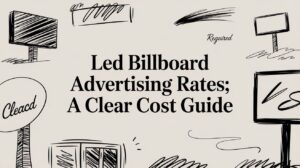
So, you're wondering about the real cost of putting an ad on an LED billboard. The short answer? It can run anywhere from $1,200 a
"*" indicates required fields